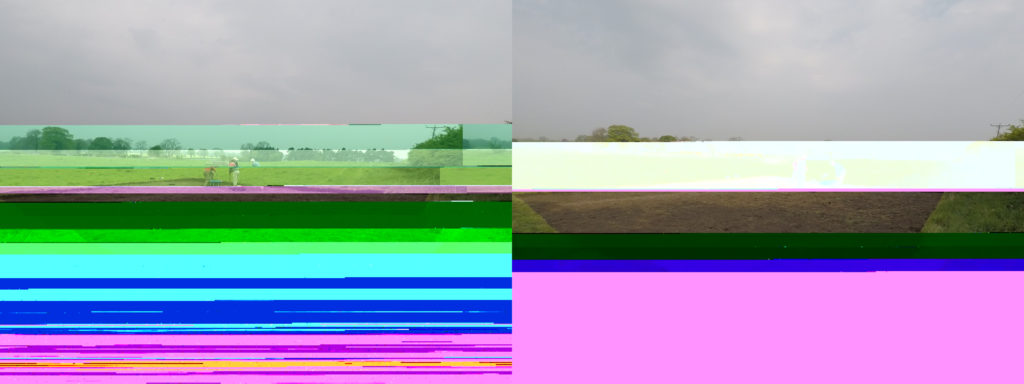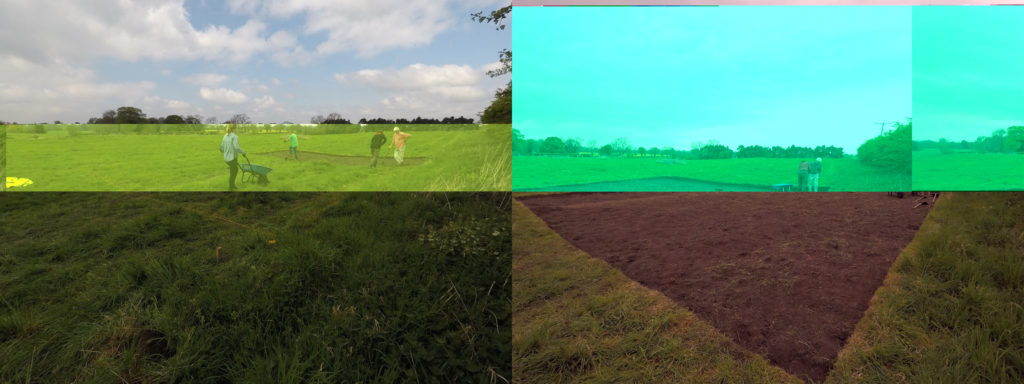GoPro Glitches

In the first of a series of ‘object writing’ blogs, Rob and Rose reflect on a series of glitchy images produced by the on-site GoPro camera.
Rob:
Rose set up a Go Pro camera on the same spot each day during the 5-week archaeological dig at Aldborough in May. The camera took a picture once a minute: documenting the transformation of an open field into an open trench (and back again). Pieced together, the images form a time lapse film of activity: people coming and going; the sky shifting; the hawthorn blossoming.
Of the thousands of images generated in this digital archive, there were a few anomalies. Some of the images taken first thing in the morning, when the air was damp and close; or when the camera battery was dwindling, carried pixellated patterns. These discontinuities often formed horizontal bands of techno-colour across the landscape – sometimes completely obscuring any representational image.
Although unintentionally formed, the images bear an echo of glitch art: the ongoing field of practice in which artists experiment with the aesthetic possibilities of digital error, failure and obsolescence. In her 2010 Glitch Studies Manifesto, Rosa Menkman writes, “The glitch is a wonderful experience of an interruption that shifts an object away from its ordinary form and discourse. For a moment I am shocked, lost and in awe, asking myself what this other utterance is, how was it created.”
Although pretty different in their visual outcomes, many of the themes in glitch art resonate with my practices exploring environmental decay, cycling and emergence, using analogue materials such as tape loops, photographic paper and Super 8mm film. Indeed, some theorists trace the lineage of ‘the glitch’ back to analogue experimentalists such as Nam June Paik, Laszlo Moholy-Nagy and John Cage, each in their own way seeking to expand the possibilities of a particular medium through processes of manipulation and distortion.
At Aldborough, these images – whether we count them as ‘errors’, ‘art’ or just ‘interesting to think with’ – highlight the processes of data collection and transformation at the site. They hint at the raw pixels and code behind seemingly flawless processes of digital documentation, exposed by fluctuations in atmospheric conditions. They are the trace of an unplanned interruption in the flow of information on-site, caused by unexpected interactions between digital memory and the prevailing weather.
Visually, their horizontal lines make me think of the layers of material memory buried under the surface of the field, and also the geophysical maps plotted from above: geometric field boundaries; lanes; buildings. What is highlighted, and what is obscured in our documentation of site? Or, perhaps we might be reminded of a ‘stuck’ webpage loading on patchy dial-up internet – something slowly being pieced into being (just like the process of the dig itself).
The glitch images make me think: what happens when we give up control (at least partially) of our creative practices in ‘collaboration’ with a site and its environmental processes? What emergent ways of working might be formed? How do we open ourselves up to uncertainty?

Rose:
These glitches are further proof to me of the joy of collaborative working. Trying to run an excavation and do creative experiment at the same time is sometimes challenging, no more so than when the technology goes wrong. When the Go-Pro started throwing out images banded with colours reminiscent of a 90s club night, striking through the landscape I was trying to capture, I was less than impressed. Downloading the camera late at night after a day in the trench, it was the last thing I wanted to see. Minutes of the dig slipped into struck-through deletion until finally I changed the SD card and learnt to shelter the camera from the more challenging weather.
But when I told Rob about these, and he looked through the collection, his excitement caught on. Once I discarded the idea that these photos were for a single purpose – a linear, uninterrupted record – they started to grow into a new sort of document. In archaeology we sometimes become weighed down by the need to record, bowed by the reflection that what we do is inherently destructive, and therefore we must do all we can to counter it with accuracy, precision and continuity. Bring in a fresh pair of eyes though, and these ‘failures’ become new modes of thinking: visually stimulating, disrupted moments.
Like Rob, my thoughts run towards ideas of layering. Stratified pixels impose themselves onto a view holding rhythms of landscape and people. What is really exciting is the way in which we can think about time in all this. As we dig, we use stratigraphy to calculate passing time, dating moments or stretched periods, often using the sections (the view of layers in the vertical sides of the trench) to map this. Some layers show clearly and can be dated, others become hard to see, undefined, or difficult to place chronologically. The glitches are stratigraphic too. They flutter and endure through the image. Sometimes they hide the landscape, and at other times they reveal figures through a strange, eerie haze, or high-exposure silhouette. We are given very specific views, whilst other elements are kept secret. Our eye is led off to some strange part of the image, or focused on a thin strip of action. The view of the past we peer at through the lens of archaeology is much the same.
There is something oddly dystopian about these glitches; perhaps more so because the original purpose of the pictures was to preserve the past, yet digital interruption has created a hazy view of an inhuman future. As well as stimulating my visual interest, Rob’s attention to this type of image has made me re-think our idea of the archaeological archive. We tend to keep the images that traditionally are considered a ‘correct record’. But what of the photographic accidents, the digital or human glitches? Taking the time to think through these images offers potential new narratives and imaginaries at the site; new modes of dealing with the complex criss-crossings of time that can sometimes be so hard to capture.
